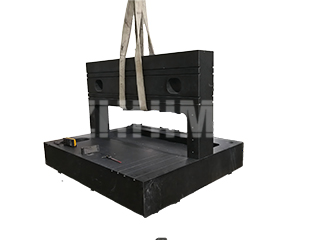The operational reliability of complex machinery—from hydraulic support systems to advanced lithography tools—is critically dependent on its customized (non-standard) base structures. When these foundations fail or deform, the necessary technical repair and replacement procedures must meticulously balance structural integrity, material properties, and the dynamic requirements of the application. The maintenance strategy for such non-standard components must pivot around a systematic evaluation of damage type, stress distribution, and functional completeness, while replacement demands rigorous adherence to compatibility validation and dynamic calibration protocols.
I. Damage Typology and Targeted Repair Strategies
Damage to custom bases typically manifests as localized fracture, failure of connection points, or excessive geometric distortion. A common failure in a hydraulic support base, for instance, is the fracture of main stiffeners, which requires a highly differentiated repair approach. If a fracture occurs at a connection point, often caused by fatigue from cyclic stress concentration, the repair mandates careful removal of covering plates, subsequent reinforcement with a parent-metal-matched steel plate, and meticulous groove welding to restore the continuity of the main rib. This is often followed by sleeving to redistribute and balance the load forces.
In the realm of high-precision equipment, repairs focus intensely on mitigating micro-damage. Consider an optical instrument base exhibiting surface micro-cracks due to prolonged vibration. The repair would utilize laser cladding technology to deposit an alloy powder precisely matched to the substrate’s composition. This technique allows for highly accurate control of the cladding layer thickness, achieving a stress-free repair that avoids the detrimental heat-affected zone and property degradation associated with conventional welding. For non-load-bearing surface scratches, an Abrasive Flow Machining (AFM) process, utilizing a semi-solid abrasive medium, can self-adapt to complex contours, eliminating surface defects while rigorously preserving the original geometric profile.
II. Validation and Compatibility Control for Replacement
The replacement of a custom base necessitates a comprehensive 3D validation system that covers geometric compatibility, material matching, and functional suitability. In a CNC machine tool base replacement project, for example, the new base design is integrated into the original machine’s Finite Element Analysis (FEA) model. Through topological optimization, the stiffness distribution of the new component is carefully matched to the old one. Crucially, a 0.1 mm elastic compensation layer may be incorporated into the contact surfaces to absorb machining vibration energy. Prior to final installation, a laser tracker performs spatial coordinate matching, ensuring parallelism between the new base and the machine’s guideways is controlled within 0.02 mm to prevent motion binding due to mounting inaccuracies.
Material compatibility is the non-negotiable core of the replacement validation. When replacing a specialized marine platform support, the new component is made from an identical grade of duplex stainless steel. Rigorous electrochemical corrosion testing is then performed to verify the minimal potential difference between the new and old materials, ensuring no galvanic corrosion is accelerated in the harsh seawater environment. For composite bases, thermal expansion coefficient matching tests are mandatory to prevent interfacial delamination caused by temperature cycling.
III. Dynamic Calibration and Functional Reconfiguration
Following replacement, full functional calibration is essential to restore the equipment’s original performance. A compelling case is the replacement of a semiconductor lithography machine base. Post-installation, a laser interferometer performs dynamic testing of the worktable’s motion accuracy. Through the precise adjustment of the base’s internal piezoelectric ceramic micro-adjusters, the positioning repeatability error can be optimized from an initial 0.5 μm down to less than 0.1 μm. For custom bases supporting rotating loads, a modal analysis is performed, often requiring the addition of damping holes or mass redistribution to shift the component’s natural resonant frequency away from the system’s operating range, thereby preventing destructive vibration overruns.
Functional reconfiguration represents an extension of the replacement process. When upgrading an aerospace engine test bench base, the new structure may be integrated with a wireless strain gauge sensor network. This network monitors stress distribution across all bearing points in real-time. The data is processed by an edge computing module and fed directly back to the control system, allowing for the dynamic adjustment of test parameters. This intelligent modification not only restores but enhances the equipment’s testing integrity and efficiency.
IV. Proactive Maintenance and Life Cycle Management
The service and replacement strategy for custom bases must be embedded within a proactive maintenance framework. For bases exposed to corrosive environments, quarterly ultrasonic non-destructive testing (NDT) is recommended, focusing on welds and stress concentration areas. For bases supporting high-frequency vibrating machinery, monthly inspection of fastener pre-tension via the torque-angle method ensures connection integrity. By establishing a damage evolution model based on crack propagation rates, operators can accurately predict the base’s remaining useful life, allowing for the strategic optimization of replacement cycles—for example, extending a gearbox base replacement from a five-year to a seven-year cycle, significantly reducing total maintenance costs.
The technical maintenance of custom bases has evolved from passive response to active, intelligent intervention. By seamlessly integrating advanced manufacturing technologies, intelligent sensing, and digital twin capabilities, the future maintenance ecosystem for non-standard structures will achieve self-diagnosis of damage, self-guided repair decisions, and optimized replacement scheduling, guaranteeing the robust operation of complex equipment globally.
Post time: Nov-14-2025

